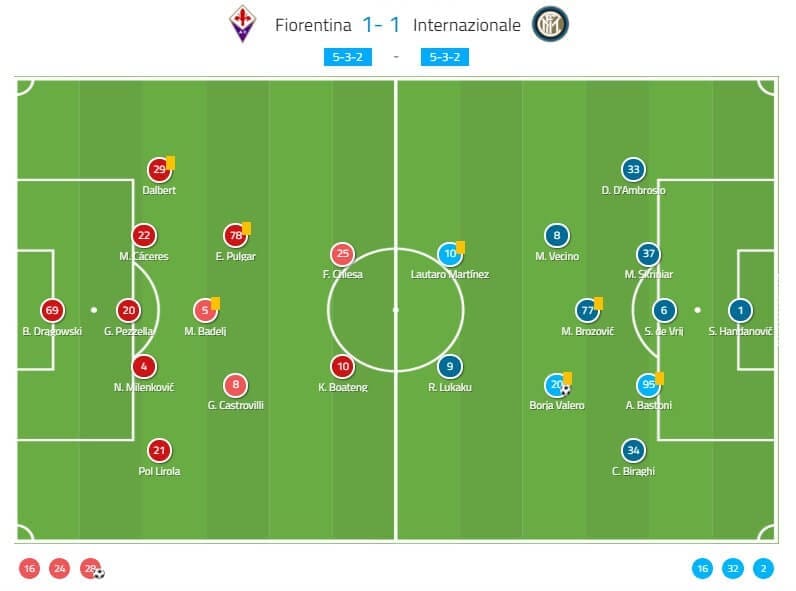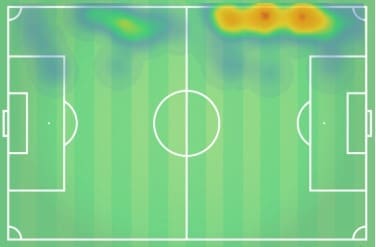The leader in Serie A Inter met some serious resistance by Fiorentina in a 1-1 draw that could have ended worse for the title contenders.
Fiorentina made their opponents regret their early opener since it increased La Viola’s attacking efforts’ frequency and pinned Inter back for the rest of the game.
The Nerazzurri had their chances too, managing to catch Fiorentina’s defence off guard, but they had more to worry about, taking care of their own defensive issues.
This tactical analysis aims to break down both team’s tactics and see how Fiorentina managed to get a point out of the game. This analysis also discusses the intricacies and nuances of the high-voltage fixture.
Lineups

Both Vincenzo Montella and Antonio Conte started with matching 5-3-2 on paper, but we could see both formations transform throughout the game, depending on the teams’ build-up process and attacking strategies.
Fiorentina’s initial set-up consisted of the keeper Bartłomiej Drągowski and a five-man defensive line including Dalbert, Martín Cáceres, Germán Pezzella, Nikola Milenković and Pol Lirola. Erick Pulgar, Milan Badelj and Gaetano Castrovilli formed the midfield trio, which supported the frontline of Federico Chiesa and Kevin-Prince Boateng. The team though would do a lot of positional rotations, transforming into more of a 3-4-3 shape in pursuit of the win.
On the goalkeeping spot for Inter was Samir Handanovič. His defensive support consisted of Cristiano Biraghi, Alessandro Bastoni, Stefan de Vrij, Milan Škriniar and Danilo D’Ambrosio. Borja Valero, Marcelo Brozović and Matías Vecino were responsible for their midfield actions, providing the ball to the front duo of Romelu Lukaku and Lautaro Martínez.
Build-up strategies

Fiore’s 5-3-2 would convert into more of a 3-4-3 in possession and Dalbert and Pol Lirola would transform into wing-backs, positioning in the opposition’s half. They’d try to build-up from the back and pass the ball from the centre-backs to the wing-backs and try retaining possession sending it to the central areas or by switching the flanks.

They were using Erick Pulgar as a playmaking figure in the midfield and as an outlet for advancing the ball up the pitch. He ended up with 93% pass accuracy and 70% overall successful actions (including duels, crosses, dribbles, shots and recoveries) proving his importance for both phases. He served as an additional passing option in their final third ventures.
Inter stuck to a more narrow shape. They were circulating the ball mainly on the flanks, using Biraghi and D’Ambrosio in a full-back/wing-back role, being positioned slightly lower than their opponents. Biraghi would move more up high, whilst D’Ambrosio would stay mostly behind the central line. The centre-back Bastoni was included in many pass combinations with Valero and Brozović on the left flank. As per usual the Croatian played a very important role in retaining possession and advancing the ball.
After their opening goal, the whole team positioned slightly lower, back to the midline, seeing the front duo often help with the build-up, picking up the ball from the central areas.

Fiorentina’s attacking force
Fiorentina’s main strategy was to overload the central areas but also have someone on the flanks who’d try to drag players out of positions and open spaces in the middle.

Especially after conceding early on, La Viola were the more attack-minded team. They ended up creating 12 shots with five of them being on target. Thanks to Handanovic’s four saves, that Inter didn’t concede more goals. Not only Fiorentina were allowed to create more positional attacks, but their efficiency was higher than their opponents. Fiorentina would catch Inter on a counter too often (six times), as one out of the six led to La Viola’s equaliser. Nerazzurii’s defenders would fail to outrun their opponents.
Fiorentina were vulnerable in the cases Inter increased their pace and used 2-3 passes to deliver the ball further too. They would sometimes fail to drop the additional men to the backline and be left defending with three players against the skilful Lautaro and Lukaku.

After the opening goal, knowing Fiorentina’s attacking abilities, Inter had to sit back in their own half. They were able to focus on defending, having the lead, but they allowed the opposition to comfortably sit in their half, which they didn’t take that for granted. They were keen on creating as many opportunities as possible. In their pursuit of that goal, they focused on sending many crosses to the box (33) making deep runs on the box, mainly thanks to Chiesa. Their low accuracy though didn’t allow them to convert them into goals.


Due to Inter’s low block at times, Fiorentina attempted many long shots (54% of their shots came from outside the box). They were trying to reach the goal shooting from distance and their average shot distance was 19,38m compared to Inter’s 10,75m.

Inter’s lack of control and awareness
Obviously, Fiorentina performed better in their offensive duels, but the more impressive is that even though they committed many players up front, they didn’t neglect their defensive responsibilities. The hosts won more than half of their defensive duels (56,25%) compared to Inter’s 41,51%.
Both teams split the possession and there was a good amount of precise passing, but what tilted the scales was Fiorentina’s time in the opposition half. It was really important for their confidence on the ball and allowed them to use their strong off the ball movement to deliver the ball to the final third and threaten the goal. Their main approach was opening gaps in the box by stretching Inter’s defensive line out wide.
Inter lost the ball in their own half on a few occasions and a whole six of them ended with their opponents’ shooting. Fiorentina would successfully recover the ball thanks to smart positioning and measured pressing duels.



Key figures
There are some players that made the difference for La Viola. Pezzella’s limited but accurate actions helped the team both defensively and in their build-up. He made impressive 23 recoveries in his own half, saving the team from a lot of trouble. He also tried contributing with long balls who allowed them to catch Inter off guard. Dalbert’s high positioning was important for the team to be able to cover the wings but also send players in the central areas. He contributed with 13 crosses.

Conclusion
There is no room for concern over Inter’s performance and talking about them losing momentum would be too soon. They do need to be careful against teams with clear attacking strategy and skilful attacking players since they find a way to exploit the littlest of spaces and have the ability to move around in a way to create those spaces on their own.
When it comes to Fiorentina, they once again failed in converting their chances into goals, which costs them a lot. They could have comfortably taken the lead on a few occasions, but they need to work on their crossing accuracy and timing.

If you love tactical analysis, then you’ll love the digital magazines from totalfootballanalysis.com – a guaranteed 100+ pages of pure tactical analysis covering topics from the Premier League, Serie A, La Liga, Bundesliga and many, many more. Buy your copy of the December issue for just ₤4.99 here






Comments